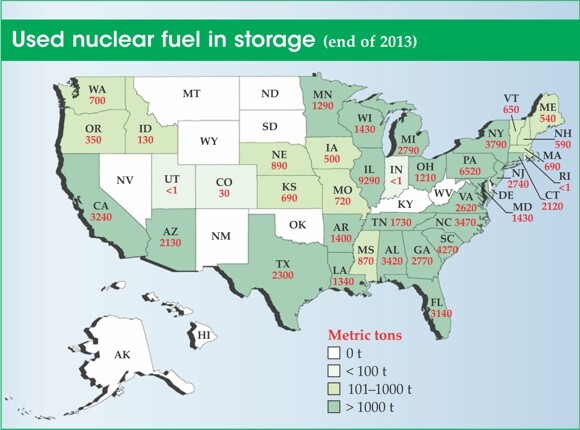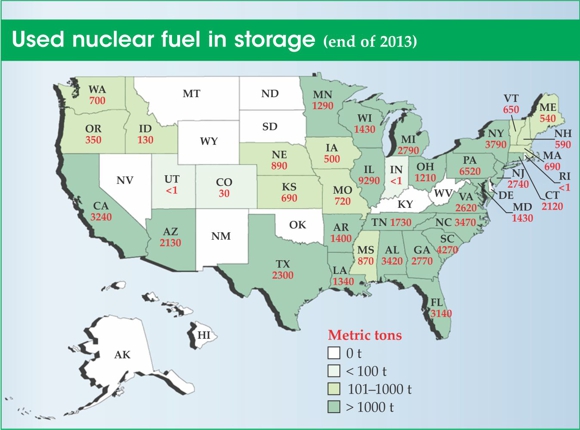US nuclear waste may have temporary home
DOI: 10.1063/PT.3.2778
Not all nuclear waste is equal, according to the Obama administration’s decision to split the disposal paths for highly radioactive waste from nuclear weapons production and the far bigger inventory of commercial spent fuel.
The decision approved by the White House should help accelerate the cleanup of defense waste, Energy Secretary Ernest Moniz announced on 24 March. The Department of Energy waste, stored at Cold War–era weapons production sites, is in various forms. Some could be disposed of more cheaply and expeditiously than via an as yet nonexistent geological repository. For example, Moniz noted that strontium and cesium, which account for more than 30% of the total radioactivity but just 0.03% of the volume of waste at the Hanford Site in Washington State, might be deposited in capsules buried in boreholes drilled several kilometers below ground. Most of the Hanford waste is in liquid form and will be vitrified for disposal in a repository. (See the article by Ian Pegg, Physics Today, February 2015, page 33
Obama’s budget request for fiscal year 2016 includes $26 million for field tests of boreholes to be drilled to a depth of about 5 km, with at least 3 km penetrating crystalline rock. Moniz said, “The anticipated low permeability of rock at this depth and the long pathway to the surface make this concept potentially very promising.”
Consent-based approach
At the same time, Moniz said he was “very encouraged” by news that Waste Control Specialists (WCS), a private firm, will apply for a license to operate an interim storage facility in west Texas for up to 40 000 tons of spent nuclear fuel. He noted that the proposal is supported by the local Andrews County community and by “elements of the state’s political establishment. This is a positive statement that it is possible to have community and state support and that a consent-based siting process is the best way to proceed,” Moniz said. “We think the proposal is certainly worth serious consideration and evaluation.” The canceled geological repository at Yucca Mountain, Nevada, would have had a capacity of 70 000 tons. Commercial spent fuel, all now stored at reactor sites (see figure above), continues to grow by about 2000 tons per year, Moniz said.

NUCLEAR ENERGY INSTITUTE

Officials for WCS said the company will submit a license application to the Nuclear Regulatory Commission by April 2016. WCS chief executive William Lindquist said he expects storage operations to commence in 2020 at the firm’s 14 000-acre location. The spent fuel would be shipped in dry casks such as those that contain much of the waste now scattered at reactor sites across the nation.
For its part, DOE will begin to “take affirmative steps with a consent-based process” to locate at least one pilot site and a full-scale interim storage facility for civilian waste, Moniz said. The pilot site would accept spent fuel from only the 12 US commercial reactor sites that have permanently closed, and the larger storage facility would house the remaining commercial waste. Storage in interim facilities “in no way minimizes the need for a permanent disposal facility,” he noted.
The WCS proposal would differ from DOE’s two-pronged plan, Moniz acknowledged, in that its facility would be built in capacity increments of 5000 tons.
Also on 24 March, bipartisan legislation was introduced in the Senate to authorize creation of an independent waste agency and construction of defense-waste-only disposal facilities. “For far too long, the American taxpayer has been on the hook for the federal government’s failure to implement an effective plan to handle the back-end of the nuclear fuel cycle,” said Lisa Murkowski, (R-AK), chair of the Senate Energy and Natural Resources Committee.
The nuclear industry welcomed the developments, particularly the provision for an independent agency. Calling the moves “overdue,” Nuclear Energy Institute president and CEO Marvin Fertel said, “The industry acknowledges DOE’s parallel development of a consolidated interim storage facility for commercial reactor fuel in a willing host community and state, and a separate repository for defense waste. These must be developed in the same time frame.”
A nuclear waste fund meant to pay for a geologic repository holds around $30 billion collected from utility ratepayers and from interest. Since 1998, when DOE failed to meet the statutory deadline to begin accepting the waste, taxpayers have paid another $2 billion or so in compensation to nuclear plant operators for their ongoing storage costs.
More about the Authors
David Kramer. dkramer@aip.org
